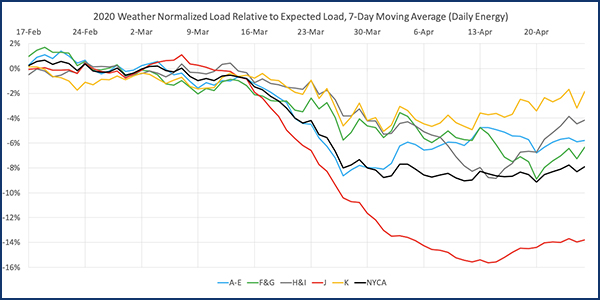NYISO will stop sequestering the operations teams at one of its two control centers even as the COVID-19 pandemic continues to reduce demand for electric power throughout New York, especially in New York City.
“We have made a decision, based on a number of factors, including the number of cases we are seeing locally in the capital region, that it is not necessary to continue to have operators sequestered at both control room sites,” NYISO Executive Vice President Emilie Nelson told the Management Committee on Wednesday.
“We plan to transition next week to have a single sequestered site at our Carmen Road facility,” Nelson said. “We will then be able to operate the Krey facility in a non-sequestered mode, but certainly with stringent, best practices in place from a health perspective.”
Most of the ISO’s staff continue to work effectively from home, she said.
In addition, the joint Board of Directors/MC meeting scheduled for June 15-16 will be held remotely, Nelson said.
COVID-19 Weighs on Load
The average location-based marginal price for March was $17.11/MWh, down from “the very low” $21.11/MWh in February and $34.91/MWh in March 2019, Vice President of Operations Wes Yeomans said as he delivered the CEO/COO report.
“The lower prices are not totally surprising as you move into March and to lower load from the impacts of the virus and lower fuel prices,” Yeomans said. “And about half the marginal price on average of last year — and again not totally surprising, given the situation.”
Demand Forecasting Manager Charles Alonge presented the estimated impacts of the pandemic on NYISO demand through April 24.
“As you’ve noticed, we’ve been in a very consistent system pattern over the past four weeks with respect to the load deficit, which has leveled off at minus 8%” systemwide, Alonge said.
“The first quarter of 2020 was generally much warmer than average, and over the last two weeks, we have seen colder-than-average temperatures — some of you have experienced snow two weeks ago,” Alonge said. “Therefore, demand deficits have been ameliorated to some extent by colder-than-average weather over the past two weeks.”
As reported at the mid-month MC meeting, the biggest impact on load was seen in New York City’s Zone J, which also has the largest commercial percentage of load in the New York Control Area.
“Zone J is posting morning ramp load levels 20% below normal at 8 a.m.,” Alonge said.
Customer Satisfaction Trends Higher
An annual performance assessment and customer satisfaction survey conducted by the Siena College Research Institute (SCRI) shows NYISO last year scoring the highest marks — or matching the record — since a new platform was adopted in 2016.
“We simultaneously assess customer satisfaction and an assessment of the NYISO’s performance offered both by market participants and CEOs over the course of the year,” SCRI Director Don Levy said. “The 2019 final score for satisfaction at 91.1, and the performance assessment score of 76.7 are merged to achieve a unified score by combining 60% of the satisfaction score and 40% of the performance assessment.”
The year-end combined score was 85.4, he said.
The performance assessment score of 76.7 matches the ISO’s score from last year exactly, with a collective score of 75 equating to slightly above very good, Levy said.
Opportunities for improvement include explanation of policies and procedures; transparency; considerations of individuals’ input; comprehensive long-term planning for the state’s electric power system; advancing technological infrastructure; and providing factual information to policymakers, stakeholders and investors.
Bylaws Revisions Re. Press Access Approved
The MC approved changes to its own bylaws to make clear that nonmembers, including the public and press, may attend committee meetings in person or by teleconference.
Kevin Lanahan, NYISO vice president for external affairs and corporate communications, presented the revisions.
The press-related bylaws proposal was prompted by a request by RTO Insider to allow its reporters to attend committee meetings by teleconference, which the bylaws at the time forbade. (See Bid to Limit NYISO News Coverage Fails.)
Nonmembers must register beforehand and “announce their presence at the beginning of or upon entering the meeting by stating their name and any organizational affiliation(s),” according to the proposal.
“We made clear under this change that any recording in any format of the MC, and this will also go for the other committees, is prohibited except by the ISO,” Lanahan said. “This is a new change, a significant change. This language does not exist yet in the bylaws anywhere.”
The changes also clarify that the secretary, ISO staff and its counsel and advisers may attend and participate in discussions at meetings of the committee, including executive sessions, and clarifies that the Public Service Commission includes the Department of Public Service.
The bylaw changes now move for votes by the Business Issues Committee and Operating Committee, Lanahan said.
Tailored Availability Metric OK’d

The MC also approved Tariff changes for the tailored availability metric project and recommended the board approve a FERC filing under Section 205 of the Federal Power Act for a May 1, 2021, implementation.
Associate Market Design Specialist Emily Conway presented the project as part of the ISO’s “Grid in Transition” process to adapt to increasing amounts of renewable energy on the system. (See NYISO Focus Turns to Grid ‘Transition’.)
The tailored availability metric project is a market design based on analysis done for availability-based resources using the equivalent forced outage rate (EFORd) to determine the seasonal derating factor (AEFORd).
The EFORd is the portion of time a unit is in demand but is unavailable because of forced outages and derates. Under the project changes the ISO will weight peak months more heavily in the AEFORd calculation.


